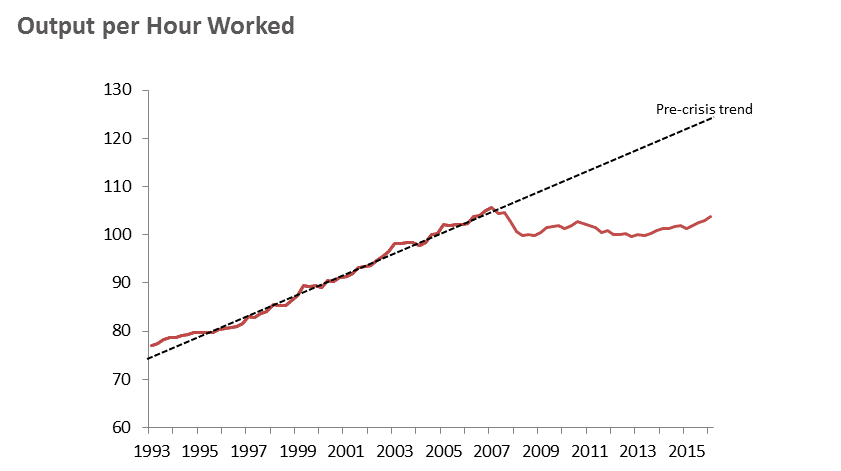Friday Flyer: Mr Hammond’s Real Choice
There are two coincident problems facing the UK economy. The first is well-known and part of the standard economic narrative and the second is almost not really paid much attention to at all. In the first case I am talking about the productivity puzzle and in the second the long sequence of primary deficits (before interest payments on public debt) on public expenditure, that have been a feature of economic life in the UK, remarkably enough, since 2002-3.
There are two coincident problems facing the UK economy. The first is well-known and part of the standard economic narrative and the second is almost not really paid much attention to at all. In the first case I am talking about the productivity puzzle and in the second the long sequence of primary deficits (before interest payments on public debt) on public expenditure, that have been a feature of economic life in the UK, remarkably enough, since 2002-3.
The charts below illustrate the labour productivity puzzle as an underperformance relative to trend since 2007. It is simple measurement but the actual performance has been a source of great surprise and comment with the gap between trend and outcomes, in some way representative of the size of the surprise. And also in the long run I show the primary and overall budget deficits since WWII and we can begin to see just how unusual our recent sequences of deficits actually is, despite the adoption of fiscal rules on about those deficits. Actually one wonders if it is the deficits that caused the rules!
Better productivity performance is rather handy for fiscal authorities because it tends to be associated with higher income growth, which means more income and consumption tax receipts, and also the likelihood of less need for transfers to lower income households. So it might very well be that a structural deterioration in the public finances may to some degree reflect a structural deterioration in the economy’s supply side.
And in so far as labour productivity is a function of capital employed, any public sector choices that directly reduce capital investment may directly reduce labour productivity. But more subtly if the sequence of deficits gives the impression of looming capital taxes, firms may adopt lower levels of capital formation than they would otherwise and this would not only help us understand lower levels of labour productivity but also low levels of investment.
Indeed some would argue the perception of growing public debt may also lead labour to choose not to supply labour because of greater expected taxes. That said our enduring high levels of employment would not suggest that this particularly distortion may not matter much in a state of high household debt. The good thing is that high levels of employment have allowed taxes to be collected even in our low productivity state.
But as often is the case in economics, we cannot really be sure if the two trends are actually connected or if they are which caused the other. What we need to understand first are the causes of both trends, which broadly speaking we are beginning to do so. The low productivity trend seems to have become embedded in advanced economies with many organisations, including the Institute, revising down their view of the growth in global and domestic capacity. The structural factors at work here revolve around increased sourcing of manufactured goods production from the emerging economics and significant mismeasurement of economies that have become increasingly digital and oriented to the service sector, as well as a domestic economy that is suffering uneven reactions to each of these trends.
The fiscal position may well, in part, be the consequence of the same weakness in the economy as this affects the tax base but may also imply that it is harder to tax what we cannot measure. Clearly the enormous consequences of the financial crisis is also playing a role but so is the question of how large do we wish the state to be. We can drift to ever higher levels of expenditure shares for public health and social security spending but do we know whether the state should be spending some 7% of GDP on health and 5% on education? And whether commitment to public investment is insufficient with, for example, total private and public expenditure on R&D is less than 2%. It might, apart from the quantity, be that our mix of public expenditure has been quite wrong and that has impacted on growth.
So what is the Chancellor to do? He might wish to work on the balance of probabilities. To consider that it is probable that public and private investment has been too low and also not well directed in across the regional and sectors and that these two factors has played a role in the productivity puzzle. And that this lack of public investment might well have contributed to poor and uneven economic performance. A commitment to stability in corporate taxes will help firms plan better in these uncertain times, and a clear statement about investment and R&D might help build the confidence that has been so withered by successive economic shocks. What might be holding the Treasury back is the rule to hit a particular deficit level by the end of this Parliament? And while a clear commitment to reduce the overall level of public debt relative to GDP over time is critical, an arbitrary choice to stabilise the deficit simply is not. So perhaps scrap the cyclically adjusted deficit target, concentrate on public investment across the regions and stop undue fiddling with corporate taxes.


















